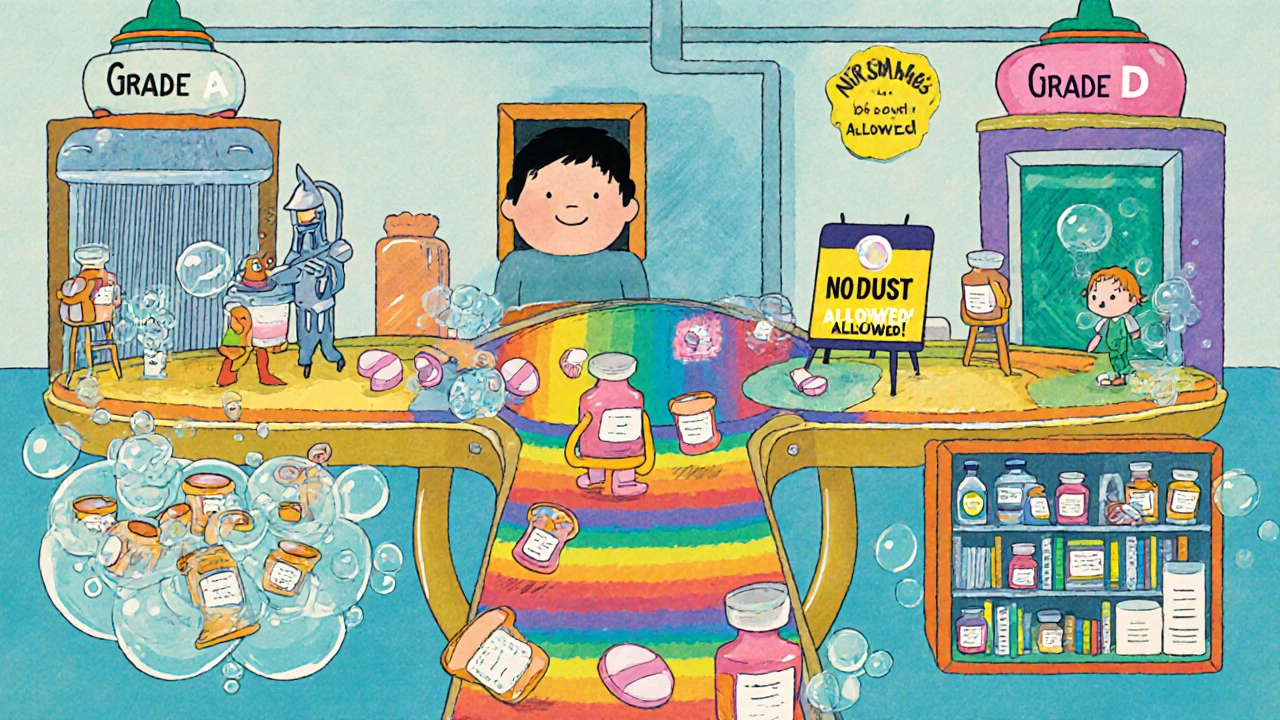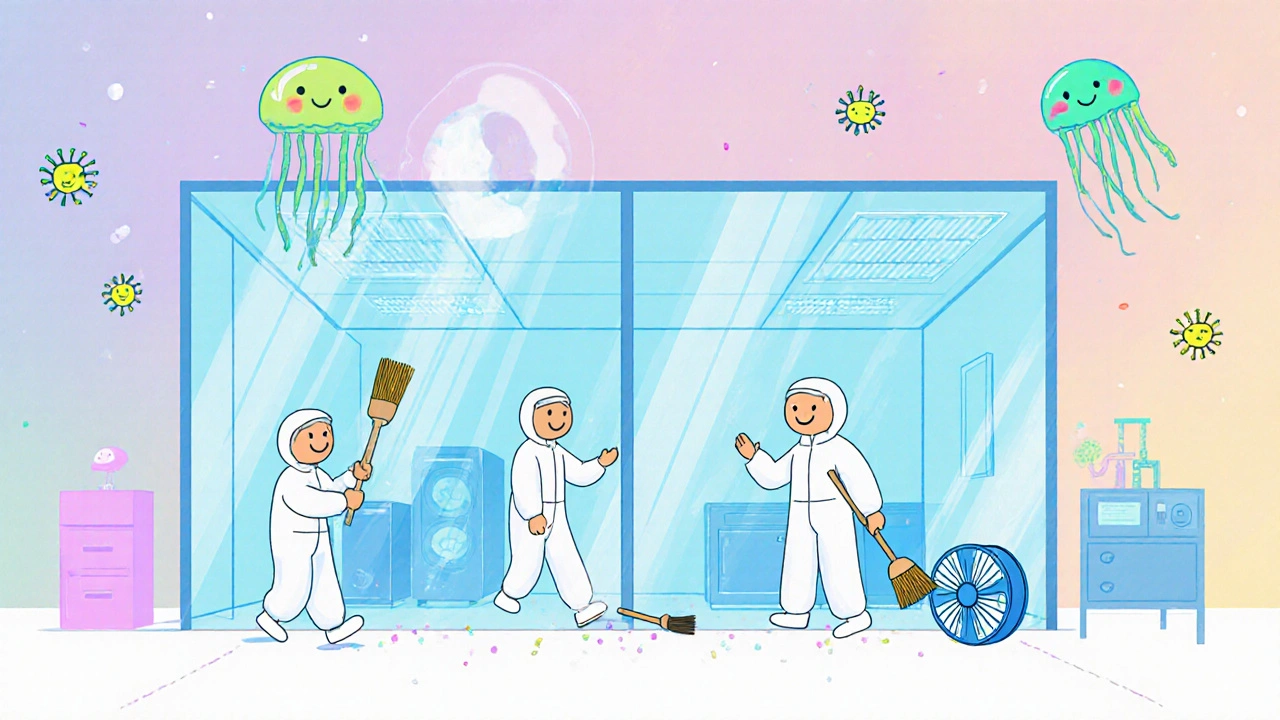When you take a generic pill, you expect it to work just like the brand-name version. But behind that simple tablet or injection is a highly controlled environment - a cleanroom - where every particle, breath, and movement is monitored to make sure the medicine is safe. For generic drug manufacturers, meeting cleanroom standards isn’t just about following rules. It’s about proving their product is identical in quality, safety, and effectiveness to the original. Fail, and you risk recalls, fines, or worse - patient harm.
Why Cleanrooms Matter for Generic Drugs
Generic drugs make up over 90% of prescriptions filled in the U.S. They’re cheaper because they don’t require the same research costs as brand-name drugs. But they must be just as good. The FDA requires that generics have the same active ingredient, strength, dosage form, and route of administration as the original. Most importantly, they must be bioequivalent - meaning they work the same way in the body. That’s where cleanrooms come in. Contamination - even tiny amounts of dust, microbes, or fibers - can change how a drug behaves. For sterile products like injectables, eye drops, or IV bags, a single particle can cause infection or reduce potency. In 2012, a compounding pharmacy’s poor cleanroom practices led to a fungal meningitis outbreak that killed 64 people. That tragedy changed everything. Today, cleanroom standards are the backbone of generic drug quality. Without them, manufacturers can’t prove their product meets the same high bar as the brand-name drug. The FDA, EU, and other regulators treat cleanroom compliance as non-negotiable.The Four Grades of Cleanrooms: What Each One Means
Pharmaceutical cleanrooms are divided into four grades, each with strict limits on particles and microbes. These aren’t arbitrary numbers - they’re based on decades of science and real-world failures.- Grade A (ISO Class 5): This is the most critical zone. Used for filling sterile products like injectables. No more than 3,520 particles ≥0.5μm per cubic meter. Airflow is unidirectional - like a constant, gentle wind blowing straight down - to sweep particles away. Temperature stays between 18-26°C, humidity at 30-60%. Air changes? At least 60 per hour. This is where the drug is most vulnerable, so every detail matters.
- Grade B (ISO Class 5 at rest, ISO Class 7 operational): Surrounds Grade A. Think of it as the buffer zone. During operations, it allows up to 3.5 million particles per cubic meter. Continuous monitoring is required. If Grade A fails, Grade B is the first line of defense.
- Grade C (ISO Class 7 at rest, ISO Class 8 operational): Used for preparing solutions and handling non-sterile components. Particle limits jump to 35 million at rest. Air changes: minimum 20 per hour. This is common in oral solid manufacturing, though some experts argue it’s overkill for non-sterile products.
- Grade D (ISO Class 8 at rest): The lowest level. Used for less sensitive operations like packaging. Only requires 10 air changes per hour. No operational particle limits - but microbial controls still apply.
How Cleanrooms Are Built and Maintained
Building a cleanroom isn’t like building a regular lab. It’s a precision engineering project.- HEPA filters are mandatory. These remove 99.95% to 99.995% of particles as small as 0.3 micrometers - smaller than most bacteria. They’re installed in ceilings and walls, and they must be tested regularly.
- Positive pressure keeps dirty air out. Grade A rooms are kept at 10-15 Pascals higher pressure than adjacent Grade B areas. If the door opens, air flows out, not in.
- Personnel gowning is a science. Workers wear full-body suits, hoods, masks, and double gloves. Training takes 40-60 hours. Even then, humans are the biggest source of contamination - shedding up to 100,000 particles per minute. That’s why movement is restricted, and every step is documented.
- Monitoring happens constantly. Air samples are taken every hour. Settle plates catch microbes. Real-time particle counters track every change. If a spike happens, the batch may be quarantined or scrapped.

The Cost of Compliance: A Heavy Burden for Generics
Innovator drug companies spend billions on R&D. Their profit margins? Often 70-80%. Generic manufacturers? 15-20%. But they still have to meet the same cleanroom standards. Building a Grade A cleanroom can cost $250-$500 per square foot. For a medium-sized facility, that’s $10 million or more. HVAC systems alone can run $2 million. Add in training, monitoring equipment, and ongoing maintenance, and cleanroom compliance eats up 15-25% of a generic manufacturer’s capital budget - compared to 10-15% for big pharma. Small manufacturers struggle. One company on Reddit said maintaining Grade A for a $0.50-per-unit heparin syringe made profitability impossible after an FDA inspection flagged minor particle excursions. The math doesn’t add up. But the cost of non-compliance is worse. In 2022, Aurobindo Pharma paid $137 million to recall sterile injectables after failing Grade B monitoring. The FDA issued 228 cGMP warning letters that year - 63% of all warning letters - and nearly half of them cited environmental control failures.Where Standards Are Changing - and Why
The EU’s Annex 1 update in August 2023 was a game-changer. It now requires:- Continuous, real-time particle and microbial monitoring
- More aggressive contamination control strategies
- Greater focus on human behavior, not just equipment

Success Stories and Hard Lessons
Teva’s generic version of Copaxone is a win. After two rejections due to contamination, they installed advanced isolator technology in their Grade A zone. Contamination events dropped from 12 per year to just 2. Approval followed. Pfizer upgraded a Grade C line to Grade B for a generic oncology drug. The $2.3 million HVAC upgrade took 14 months of downtime. But it prevented 17 out-of-spec batches annually - worth $8.5 million in lost product. On the flip side, poor training led to a 2023 recall at a U.S. generic manufacturer. A technician skipped gowning steps. A single glove tear introduced microbes into a batch of eye drops. The batch was destroyed. The company was fined. And patients lost trust.What Generic Manufacturers Can Do
If you’re running a generic drug facility, here’s what works:- Invest in training - not just once, but continuously. Personnel errors cause 42% of deviations.
- Use real-time monitoring - don’t wait for lab results. Catch spikes before they become problems.
- Don’t cut corners on HVAC - it’s the backbone of your cleanroom. Poor airflow = contaminated product.
- Document everything - 15-20 SOPs are required. If it’s not written down, it didn’t happen.
- Use free resources - the FDA offers free cGMP training. ISPE and PDA publish practical guides.
The Future: Automation and Smarter Cleanrooms
The good news? Technology is helping. Robotics are replacing human tasks in Grade A zones. AI-powered sensors predict contamination before it happens. Single-use systems reduce cleaning needs. McKinsey predicts automation will cut cleanroom operational costs by 25-30% by 2028. But the demand for higher standards won’t slow. By 2025, half of all new generic drug applications will require Grade A or B environments - up from 35% in 2022. Cleanroom standards aren’t going away. They’re getting tighter. And for generic manufacturers, the only way to survive is to embrace them - not as a cost, but as a competitive advantage.Because in the end, a cleanroom isn’t just a room with filters. It’s the silent guardian of patient safety. And for generic drugs - where trust is everything - that’s worth every dollar.



Comments (13)
Kelsey Veg
so like… i work in a lab and we dont even have a grade a room and we make glue for bandages. how the hell are small generic companies supposed to afford this? $500 a sq ft?? we pay $20 for a box of gloves. this is insane.
Alex Harrison
i read this whole thing and my head hurts. i get that safety matters but its like they’re building a space station to make ibuprofen. why does a pill need 60 air changes per hour? i just want it to stop my headache, not sterilize my soul.
Jay Wallace
Of course the FDA doesn't use ISO labels-because American standards are superior, obviously. The EU? They're still using decimal points and metric units. How quaint. We don't need their 'Annex 1' nonsense. Our regulations are written in blood, sweat, and taxpayer dollars-and they're not going anywhere. If you can't keep up, don't make medicine.
Alyssa Fisher
It’s fascinating how we treat medicine like a sacred object-when in reality, it’s just chemistry. A molecule doesn’t care if it was made in a Grade A room or a garage with a HEPA filter taped to a fan. But we’ve built this entire ritual around sterility because we’re terrified of being wrong. The real tragedy isn’t contamination-it’s that we’ve turned healing into a performance.
Alyssa Salazar
Let’s be real-cleanroom compliance isn’t about patient safety, it’s about liability mitigation. The FDA doesn’t care if your drug works-they care if you documented the humidity level on Tuesday at 3:17 PM. That’s why 63% of warning letters are about environmental controls. It’s bureaucratic theater. The science is solid, but the paperwork? It’s a maze designed to bankrupt small players.
Beth Banham
Interesting read. I didn’t realize how much goes into a $0.50 syringe. Makes me appreciate the people who make these things, even if they’re not famous.
Brierly Davis
Biggest takeaway: training > equipment. You can have the fanciest filters, but if your tech skips gowning because they’re rushed, you’re screwed. Invest in people. They’re the real contamination source-and the real solution.
Amber O'Sullivan
Grade D is just a glorified closet with a fan and a prayer. Why are we pretending it’s science when it’s just paperwork with a label?
Jim Oliver
Of course small manufacturers can’t afford this. That’s why they shouldn’t be making medicine. If you can’t afford a $10M cleanroom, you’re not qualified. Stop pretending you’re ‘saving money’-you’re risking lives. And yes, I’m angry.
William Priest
Did you know the EU’s Annex 1 was written by a guy who used to work for a German pharmaceutical conglomerate that outsourced to China? So now we’re all following rules written by bureaucrats who’ve never seen a HEPA filter? Brilliant. Meanwhile, the FDA is still using typewriters in some offices. This isn’t regulation-it’s cultural imperialism disguised as science.
Ryan Masuga
Hey, if you’re a small company struggling with this-don’t panic. Partner up. Use contract manufacturers. There are legit ones out there with certified rooms and good reputations. It’s not cheating-it’s smart. And yeah, automation is coming. Robots don’t sneeze. They don’t forget to change gloves. And they don’t cost $200k a year in training. This isn’t the end-it’s the evolution.
Jennifer Bedrosian
Someone actually got fined because a GLOVE TORE?? I mean… like… that’s it? That’s the whole story? One little rip and they destroy a whole batch? And the patient who needed it? Too bad? I mean… come on. This is like banning all cars because someone once ran a red light. We’re turning healthcare into a horror movie.
Lashonda Rene
i just think about how many people take these pills every day and never think about the room they were made in. it’s wild. like, i don’t know how to make a pill but i know i trust that it works. and if it costs a lot to make sure it’s safe, then maybe it’s worth it. even if it’s confusing. even if it’s expensive. even if it’s weird. we all just want to feel better. and if a cleanroom helps with that, then maybe we should just be quiet and let the people who know what they’re doing do their job. no drama. no yelling. just quiet, careful work. that’s all.